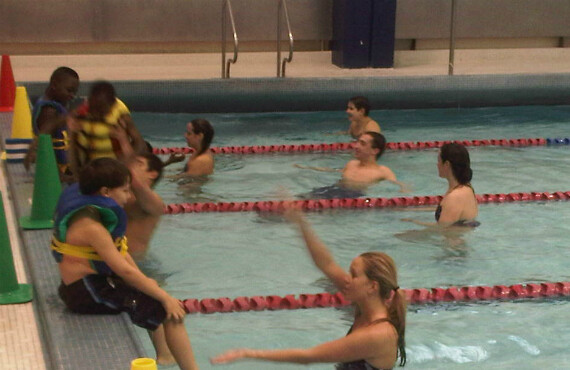Penn Students Encourage Lea School Children to Get in the Swim of Things
Philadelphia has the fourth-highest drowning rate among children, and drowning is the leading cause of death among those aged 1-4. In 2005-2009, African-American children aged 5-14 were three times more likely to drown than whites.
Some students at the University of Pennsylvania are taking aim at those sad statistics by teaching life-saving skills in the pool to youngsters from Penn’s West Philadelphia neighborhood.
Leading the way is Clarissa Palmer, a junior at the College of Arts and Sciences, majoring in classical studies with a minor in sociology.
Palmer has been swimming on the varsity team at Penn for the past three years. Growing up, she one of the only African-American swimmers on her team in Randolph, Mass.
“I believe in turning my uniqueness into a ‘normalcy’ for the upcoming generation,” Palmer explains.
She is one of the three co-founders of “We Can Swim!” It is a new program at the Sheerr Pool in Penn’s David Pottruck Health and Fitness Center. Palmer’s goals are to diversify the field of competitive swimming and to reduce drowning rates among minorities younger than 14.
Each Saturday morning for eight weeks, students from the Henry C. Lea Elementary School will work with instructors who have volunteered to teach young, underserved urban children how to swim. It’s not only a great way to keep cool and stay fit, but knowing how to swim could save that child’s life.
Palmer saw a need for the children in Lea that warranted attention, and she worked closely with Penn’s Netter Center for Community Partnerships to bring “We Can Swim” to fruition.
This pilot program began in mid-March. The only requirements are that each child is a second-, third- or fourth-grade student at Lea and the parents sign the necessary paperwork. The fee is $10, which covers eight Saturdays of 30-minute swimming lessons.
Organizers are looking to eventually branch out, offering the program year after year and opening it up to more students in other grades.
“I want to teach every child enrolled in the Lea School how to swim –- and have them be our model,” explains Dan Schupsky, another co-founder of “We Can Swim.” A graduate student at Penn, he will earn his masters of environmental studies, with a focus on sustainability in athletics, in May 2014. He also works as Penn’s aquatics coordinator and varsity assistant swim coach for the men’s and women’s teams.
Schupsky says “We Can Swim!” offers long-term staying power.
“We Can Swim!” embraces Penn’s commitment to local engagement by working to strengthen the University’s relationship with nearby residents and specifically students at Lea.
“Penn shares a proud history with Lea School for many years,” says Glenn Bryan, assistant vice president of community relations in the Office of Government and Community Affairs. “This reflects a renewed collaborative spirit of engagement between Penn and its community partners.”
There are 15 participating Lea students paired with 15 volunteer instructors. The swim teachers are mostly members of Penn’s varsity teams.
I’m glad to know that I could do something that will affect others for the better. This program is like my baby,” Palmer says. “I’m a proud parent, nurturing it and helping it grow. When I graduate, I hope to be that parent that lets their kid thrive on its own, because they already did all they can do to help their child have a solid base.”
“I once told Clarissa,” Schupsky says, “that many students come here and positively transform their worlds, stepping into new leadership roles and inspiring those around them. And now she has done just that. It is going to be a powerfully positive legacy and community connection that she leaves here at Penn.”








